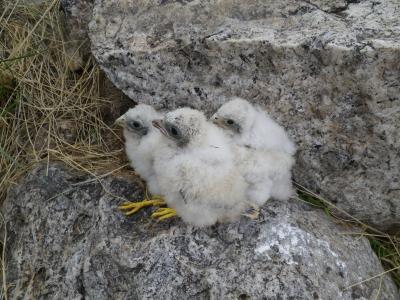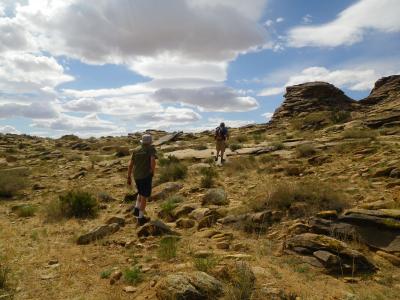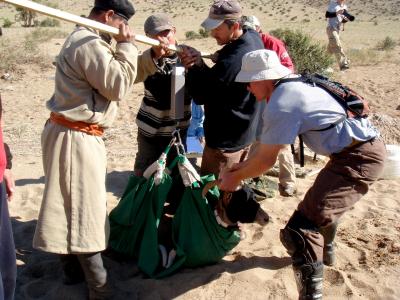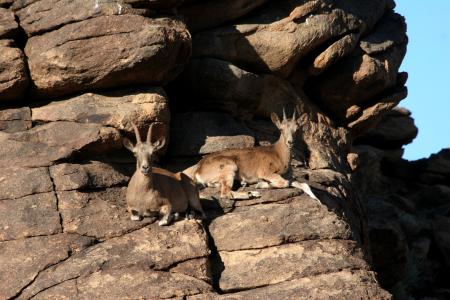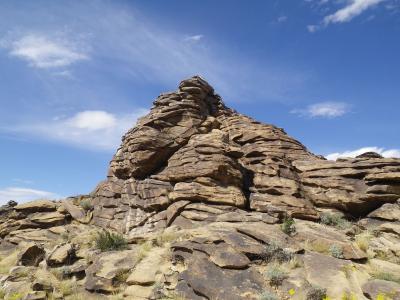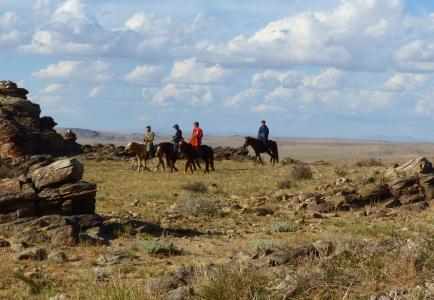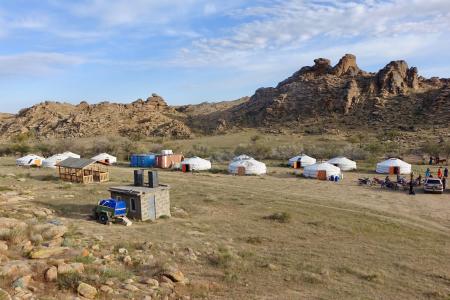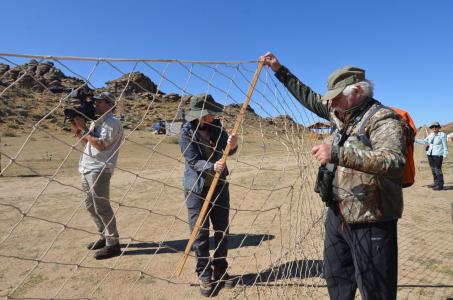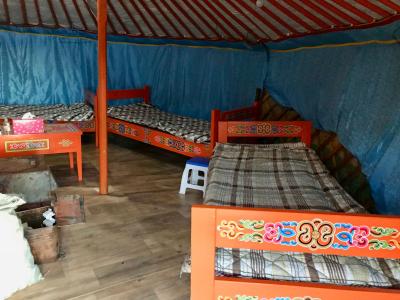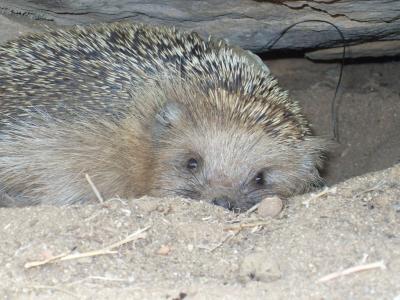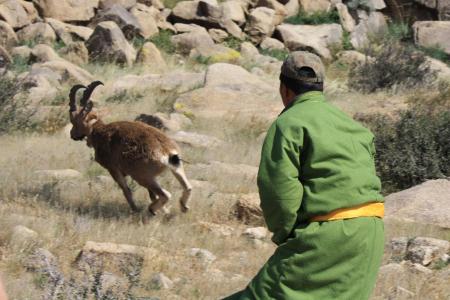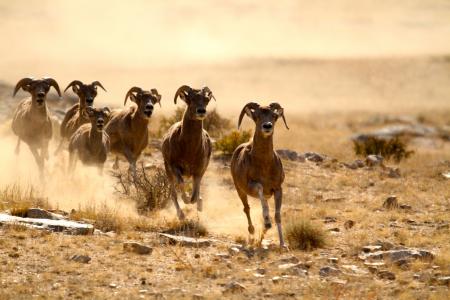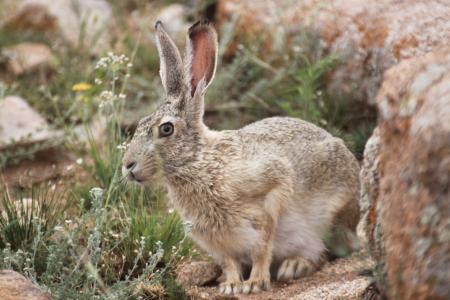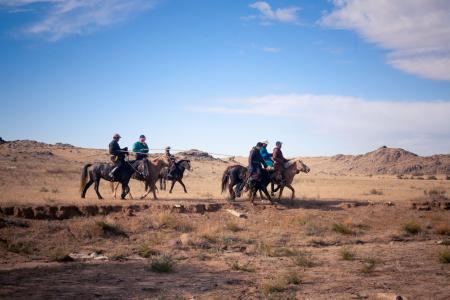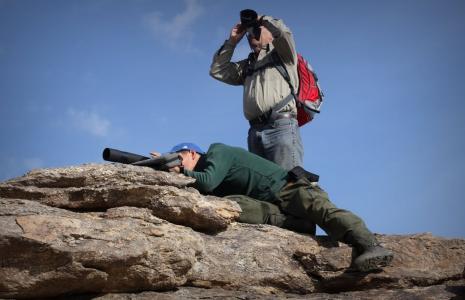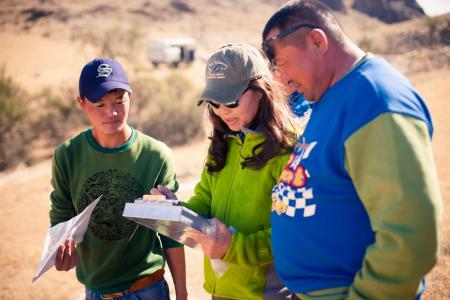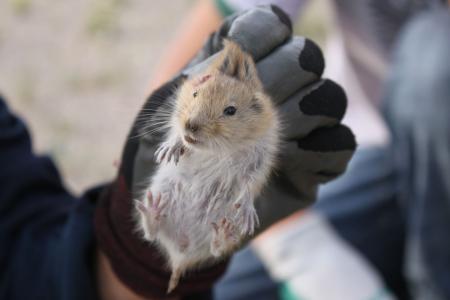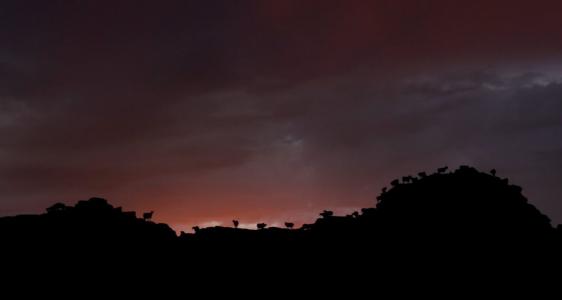Please read the following information carefully before leaving for your expedition.
Wildlife of the Mongolian Steppe
Expedition Briefing
Quick Navigation: COVID-19 Safety | The Research | Research Aims | How You Will Help | Life in the Field | Accommodations and Food | Project Conditions | Essential Eligibility Requirements | Health and Safety | Project Risks and Precautions | Travel Planning | Additional Resources
Click on the images to view full size!
COVID-19 Safety
You are strongly encouraged to test for COVID-19 before traveling to your expedition, particularly if you are experiencing symptoms. Do not travel if you have tested positive, and call Earthwatch right away for the next steps. Please see earthwatch.org/covid-19 for more information.
The Research
Mongolia hosts a rich diversity of wildlife, especially compared with other Central Asian nations. Ikh Nart Nature Reserve, 66,600 hectares (257 square miles) of grassland and arid steppe habitats, provides a protected home for many species. But even within the bounds of the reserve, the animals of Ikh Nart face threats from poaching, illegal mining, shifts in water availability and vegetation associated with climate change, and overgrazing. Local soums (counties) manage protected areas for the Mongolian federal government but lack the infrastructure and resources to provide active stewardship.
One species that needs our protection is the endangered argali sheep, the largest mountain sheep in the world. Ikh Nart shelters one of the last populations of these sheep, which, research suggests, have declined primarily due to poaching and conflicts with domestic livestock production.
We initially began researching in Ikh Nart to develop strategies to conserve this majestic beast, but as the project grew, we started to collect data on the other important species: the globally declining lesser kestrel, the cinereous vulture, the Siberian ibex (wild goat), multiple species of hedgehogs and small carnivores, the Siberian marmot, Pallas’s Coluber (a snake), and many small prey species including lizards, insects, and small mammals such as gerbils and hamsters. The more we understand these species and how they interact with each other and their environment, the better we can develop plans to conserve them in the future. Recently, we held a workshop to develop Ikh Nart Nature Reserve’s Open Standards conceptual model to guide the new 5-year park management plan. This workshop identified eight priority conservation targets: Argali, Ibex, Mongolian and Goitered gazelles, Cinereous vultures, saker falcons, and marmots. We’ve also identified threats such as poaching, water availability, and pasture and rangeland availability, and we’re primarily researching these species until 2027.
Wildlife of the Mongolian Steppe
Research Aims
Simply put, our research focuses on how different species use resources and influence each other in this unique desert environment. For example, we explore how argali and ibex coexist and the impact of domestic sheep and goats on argali and ibex. We also explore how Goitered gazelle and domestic camels coexist in the arid desert environment, and we examine the grassland health and vegetation availability. We also examine nesting behavior, movement patterns, and diet of large birds of prey.
Already, the results of this work have helped improve the conservation of these species and the ecosystem on which they depend. We have successfully recommended conservation strategies to the Mongolian government, other biologists, and nongovernmental organizations working to conserve and recover species in Mongolia. We also work closely with local communities to increase their support for conservation and to try to induce changes in livestock husbandry and wildlife use practices that will benefit the area’s wildlife. Simply by having a research presence in the park, we have cut down on poaching. So, at the core, this project is about understanding coexistence among various related species in the wild and between local communities, their livestock, and the wildlife they share the steppe with.
Wildlife of the Mongolian Steppe
How You Will Help
Because the research spans from small mammals to cinereous vultures, you will have the opportunity to work with various species, performing a broad range of tasks. Few people get this opportunity because many species remain shy and inhabit inaccessible areas. At Ikh Nart, however, wildlife is becoming increasingly habituated to human presence, especially to people on foot. In other words, their flight distance has become shorter due to less disturbance and poaching. Few people worldwide have seen argali sheep up close, but at Ikh Nart, our team members often get within 100 meters of these endangered animals. Working with the project’s large, friendly team of Mongolian experts and students permits you to develop strong relationships with staff members.
Before you begin fieldwork, you’ll receive training on project equipment use and research techniques. We’ll stress the importance of remaining unseen by target animals during data collection. You’ll also learn from informal lectures while on the ride to the project site and in the evenings while in the field, and we’ll guide you on local customs during visits to nomadic families. Researchers at Ikh Nart have provided some of the best opportunities to train Mongolian university students in field research methods in the country, and your involvement in working alongside these students is a critical part of their development and growth as scientists.
Tasks that you may perform include the following listed below. Please note that some tasks are restricted to teams or months:
Earthwatch Team 1
- Collecting nesting success data on cinereous vultures and lesser kestrels.
- Collecting vegetation samples from 50 veg plots at the study site
- Trapping small mammals, tagging them with ear tags, and taking measurements
- Conducting line transect surveys for argali sheep and Siberian ibex (5km (3 miles)walk on transects 1–2 times)
- Entering data collected daily from the above
Earthwatch Team 2
- Handling ~60 cinereous vultures, including taking measurements of nestlings and wing tagging them
- Collecting vegetation samples from 50 veg plots at the study site and cutting biomass from 50 veg plots
- Trapping small mammals, tagging them with ear tags, and taking biometric measurements
- Conducting line transect surveys for argali sheep and Siberian ibex (5km (3 miles) walk on transects 1–2 times)
- Entering data collected daily from the above
Earthwatch Team 3
- Conducting grassland management and ecological restoration by building ~60 rock dams
- Trapping small mammals, tagging them with ear tags, and taking biometric measurements (this task will be weather-dependent)
- Conducting line transect surveys for argali sheep and Siberian ibex (5km (3 miles) walk on transects 1–2 times)
- Handling cinereous vultures, including taking measurements of nestlings and wing tagging them (this task is dependent on the size of the fledglings at the time of this team)
- Entering data collected daily from the above
Earthwatch Team 4
- Assist in capturing argali, ibex, and Goitered gazelles in “drive nets”: volunteers will help with setting up 900 yards capture nets daily (please see Essential Eligibility Requirements section below for details of specific physical requirements on this team to complete this task)
- Assist in checking the body temperature of captured animals, data entry, taking pictures, and supplying water for the captured animals for cooling.
- Conducting line transect surveys for argali sheep and Siberian ibex (5km (3 miles) walk on transects 1–2 times)
- Entering data collected daily from the above
Wildlife of the Mongolian Steppe
Life in the Field
We are far from the big city, but you will have time at the beginning and end of the expedition to explore Ulaanbaatar. While at Ikh Nart, we will have a half-day off for a Mongolian-style barbecue and recreation, including hiking and wildlife watching.
The local women’s craft collective, Ikh Nart Is Our Future, will visit most teams. The collective provides income for local women by producing felt and other Mongolian craft items made almost exclusively from local materials. You will have the opportunity to purchase traditional handicrafts inspired by the beauty of the Ikh Nart Nature Reserve, with all proceeds directly benefiting the collective.
Each team will wrap up with a recreational day in Ulaanbaatar. Several field staff will guide the team through certain sites in and around the city. Optional activities at an additional cost to volunteers include visiting the museum under the Chingis Khan Statue (30,000 MNT (12 USD) entrance fee per person) and a cultural show (35,000 MNT (13 USD) per person. Prices are subject to change.)
DAILY ACTIVITIES
Weather and research needs can lead to changes in the daily schedule. We appreciate your cooperation and understanding.
ITINERARY
Teams 1–3
- Day 1: Rendezvous in Ulaanbaatar, settle in, optional cultural activities on your own, and group dinner.
- Day 2: Drive from Ulaanbaatar to the field site (approx. 6.5 hours), settle in, and get acquainted with the site.
- Day 3: Half-day orientation and training. The second half of the day will be spent on data collection (setting up small mammal trapping grids, vegetation sampling, transect walks, raptor nest monitoring, etc.).
- Days 4–6: Data collection
- Day 7: Data collection in the morning, traditional Mongolian barbeque in the afternoon and evening
- Days 8–11: Data collection.
- Day 12: Leave for Ulaanbaatar after lunch. Arrive in Ulaanbaatar in the evening and settle into the guest house.
- Day 13: Morning sightseeing or visit a local university or scientific institute. Drive to Terelj National Park. Visit Chingis Khan Statue. Optional visit inside the museum for an additional fee of around 30,000 MNT (12 USD) paid by volunteers. Lunch at a tourist camp. Return to Ulaanbaatar. Optional cultural show in the evening for an additional fee of approximately 35,000 MNT (13 USD) paid by volunteers. And a farewell dinner at 7:30 pm.
- Day 14: Breakfast and depart for the airport to catch a flight home.
Team 4
- Days 1–3: Same as other teams.
- Days 4–6: Drive-netting argali, ibex, and Goitered gazelles and data collection (data recording, morphometric data collection, animal health monitoring, satellite-collaring, and still and video photography).
- Day 7: Drive-netting argali and ibex before noon; in the afternoon, traditional Mongolian barbeque
- Days 8–12: More drive netting and line transect sampling at the end of the capture days.
- Days 12–14: Same as other teams.
Please note that depending on what research activities you are involved with, the above schedule is likely to shift to accommodate the work required and to accommodate travel to the southern part of the reserve, if required.
TYPICAL DAILY SCHEDULE
- 6:00 a.m.: Some volunteers and staff rise and check small mammal traps
- 7:00 a.m.: Breakfast, lunch preparation, wash up
- 8:00 a.m.: Collect gear, break into groups, and receive a quick briefing on the day’s tasks
- 8:30 a.m.: Fieldwork
- 1:00 p.m.: Break for lunch
- 2:00 p.m.: Fieldwork
- 5:00 p.m.: Wash up, prepare dinner, data entry
- 7:00 p.m.: Dinner, recreational and rest time, etc.
Wildlife of the Mongolian Steppe
Accommodations and Food
* Please note that not every expedition has couples’ or singles' accommodations available. Please call or email Earthwatch to check availability before reserving your space(s) on the team.
SLEEPING
ULAANBAATAR
Zaya’s Guesthouse in Ulaanbaatar is comfortable and clean. When possible, we can house couples together with advance notice to Earthwatch. Some rooms have their own bathrooms, although some guests must share. The guesthouse comprises a few large apartments with kitchens, living rooms, bathrooms, and bedrooms that we rent. The guesthouse offers breakfast and has free internet access on one computer. Zaya’s sits in the heart of Ulaanbaatar, within easy walking distance of tourist sites, restaurants, banks, and shopping areas.
Zaya’s Guesthouse offers transport to and from the airport for a reasonable fee and can help arrange excursions at your own expense before or after the Earthwatch expedition. They have a comprehensive list of equipment and camping gear that can be rented and can send you a list of what’s available, with costs, if you email them at info@zayahostel.com.
Please specify that you are with Earthwatch if you book additional nights at Zaya’s before or after the expedition.
IKH NART
The research camp lies in the heart of the project’s study area. You’ll stay in traditional Mongolian gers (yurts) at the camp. There are currently eight gers at the research camp, five of which are for your lodging. There is also a kitchen, dining, and two staff gers.
Participants will be assigned gers by gender; each ger can accommodate up to four participants. Single and couple gers are subject to availability and will depend on numbers and the gender makeup of the team. Please request this when booking and note it on your volunteer forms. When possible, participant requests will be accommodated in the order they were received.
Gers are larger than standard tents (you can easily stand upright in them), have storage space, water filters, and washbasins, and tend to be warmer than tents at night. The research site has three standard tents for Earthwatch team use, but you may also bring your own if you like.
All team members will sleep on beds, but you should bring sleeping bags, as we have no linens. You’ll get a sleeping pad (but we recommend bringing your own for added padding). It can get cold at night, so please bring a warm bag and layers of clothing. Also, bring your own towels (camp towels work great and are available at most outdoor stores).
* Earthwatch will honor each person’s assertion of gender identity respectfully and without judgment. For both teen and adult teams, where logistics dictate single-sex accommodations or other facilities, participant placements will be made in accordance with the gender identity the participant specified on their Earthwatch Participant form and/or preferences indicated in discussions with Earthwatch.
BATHROOMS
There is one outhouse with two sit-down “eco-design” toilets. They are composted with dry manure, and you will be instructed in their use on arrival. In the field, you’ll follow the nomadic tradition of using the great outdoors when nature calls.
Several “sun showers” (insulated bags that hold water warmed by sunlight) are available at camp so that you can wash regularly.
ELECTRICITY
The research project gets electricity from solar panels. We use this energy to recharge project equipment, but there’s usually enough power to recharge your electrical items (project equipment has priority). Gers have lights for reading, etc. We have outlets for American and European electronics. Outlets are 220 volts, 50 Hz two-prong Type C European-style plugs (American-style outlets are also available in camp).
DISTANCE TO THE FIELD SITE
Although we sometimes use vehicles to access portions of the reserve, we sometimes walk to our work.
REFRIGERATION
Zaya’s Guesthouse has refrigeration available and can store medications as needed.
The research station has a naturally cooled underground cellar and a freezer for storage.
Please Note: There is a 6+ hour drive on Day 2 for teams from the main city to the research station. Refrigeration will not be available during this commute.
ADDITIONAL POLICIES
Participants may not ride motorcycles, horses, or camels during Earthwatch expeditions for safety reasons. If you wish to ride horses or other animals during your visit to Mongolia, please do so before or after the expedition. While there may be an opportunity to observe traditional Mongolian wrestling, participants are not allowed to wrestle.
FOOD AND WATER
A cook will prepare most meals. We’ll generally eat breakfast, lunch, and dinner together, and sometimes, you’ll make your own packed lunch with food set out each morning to take into the field. All Earthwatch participants and staff members will be expected to assist in cleaning up after meals.
TYPICAL MEALS
The following are examples of foods you may find in the field. Variety depends on availability. We appreciate your flexibility.
- Breakfast: Fresh bread, hot rice or wheat porridge, rolls and jam, eggs, cheese, and Mongolian sausage
- Lunch: Often cooked lunch at the research camp OR sometimes sandwiches with various fillings (peanut butter and jelly, cheese, tomato, salami), apples, cucumbers, cookies, crackers, and traditional Mongolian baked goods
- Dinner: Mixed vegetable and meat stew, pasta, soup, salad, traditional Mongolian meals with emphasis on meat
- Snacks: Chocolate, cookies, peanuts, Mongolian baked goods (you may want to bring protein bars or some other favorite snack to eat while in the field)
- Beverages: Juice, tea, instant coffee, spring water, and some soda
- Water: We drink water from a small spring near the research camp. All team members should assist in collecting water. Gers have passive water filters. The filters clog frequently when used heavily and, therefore, need to be cleaned regularly (once every other day). We’ll ask you to help clean the filters. If the passive filters are kept full, they provide more than enough water for the team.
- Alcohol: On this project, we strive to maintain an alcohol-free research camp. Please do not bring any alcohol with you.
- Barbeque: Additionally, project staff will endeavor to hold one ceremonial Mongolian barbeque for each team. This entails the killing of a goat (sometimes a sheep) and heating hot rocks. The rocks and meat are placed in a kind of pressure cooker. The meat is consumed off the bone, and the rocks are passed around; supposedly, they are great for your health and should be handled while still hot.
SPECIAL DIETARY REQUIREMENTS
Please alert Earthwatch to any special dietary requirements (e.g., diabetes, lactose intolerance, nut or other food allergies, vegetarian or vegan diets) as soon as possible and note them in the space on your volunteer forms.
Accommodating special diets is not guaranteed and can be very difficult due to the availability of food, the location of field sites, and other local conditions.
Special Note: Gluten-free diets cannot be accommodated on this expedition.
Vegan diets are very difficult to accommodate on teams. Volunteers with vegan dietary restrictions will need to bring their supplemental food and snacks to support their diet for the duration of the team. Participants can purchase groceries at the State Department Store on Day 1 of your team in Mongolia. However, vegan options will be limited. Some examples of what you may find at the store for purchase include fresh produce, rice, pasta, tofu, juice, and almond/oat milk (it isn't easy to find beans in Mongolia). Though refrigeration is available at the research station, items requiring immediate refrigeration or freezer storage are discouraged as they cannot be properly stored in vehicles during the 6+ hour drive from the main city to the research site on Day 2 of teams.
Wildlife of the Mongolian Steppe
Project Conditions
The following information is as accurate as possible, but please remember that conditions may change.
The terrain in Ikh Nart is sparsely covered by semi-arid steppe vegetation with several large rocky outcrops. The altitude is approximately 1,250 meters (4,100 feet). Permanent cold-water springs are present in some of the shallow valleys draining the reserve.
Temperatures range considerably from day to day and even within a single day. It can get cold in June and around September, especially at night. Alternatively, June, July, and increasingly August can be hot. Average temperature breakdown by team:
- June Teams: Low 40℉– 50℉ at night and high 60℉ -80℉ during day
- July/Early August Teams: Low 50℉–60℉ at night and high w 80℉– 90℉ during day
- Mid-late August Teams: Low 40℉–50℉ at night and high with 60℉–70℉ during day
- September Teams: Low 30℉–40℉ at night and with high 60℉ during day
For more details on the climate, you can visit Dalanjargalan, Mongolia weather in July: average temperature & climate (wanderlog.com)
Precipitation is generally low, though most falls in the summer, and severe thunderstorms or flash floods can occur. These are more likely to occur in late June or early July.
Wildlife of the Mongolian Steppe
Essential Eligibility Requirements
All participants must be able to:
- Enjoy being outdoors all day in all types of weather (see above), in the potential presence of wild animals and insects.
- Tolerate vastly varying temperatures as low as -12 °C (10°F) at night and over 38°C (100°F) during the day.
- Tolerate long periods spent working in direct sunlight with little to no shade available (4–6 hours per day)
- Get low enough to the ground to set and check small mammal traps for up to 1- 2 hours per day.
- Traverse distances up to 3 miles (5 km). For these transects, the terrain in Ikh Nart can be uneven, with shallow and occasionally steep drainages and valleys, making hiking fairly strenuous. Volunteers can expect some hiking to be over steep rocky outcrops (often with loose rock debris) or through soft sand. However, volunteers can speak with project staff during the team to confirm a transect that best fits their walking abilities. No volunteers will be asked to exert themselves more than they are comfortable. Once out of camp, there are restricted means of communication, so ensuring that you are well-hydrated and working within your fitness and comfort levels is important, as help will take time if required.
- Carry a light daypack (under 2.3 kg/5 lbs.) while out in the field with personal daily supplies such as lunch, water, and some basic field gear (binoculars, GPS unit, range finders, etc.).
- Team 4 Only: When assisting in capturing argali, ibex, and Goitered gazelles, all participants must be able to:
- Bend over frequently to support with setting up nets
- Must be comfortable sitting down on the ground for up to 6 hours/day (pads will be provided to sit on).
- Get up and down from the ground without assistance
- Walk 900 yards daily over uneven terrain (in addition to the 3 miles (5km) mentioned above).
- Be comfortable assisting in the capture and restraint of argali and ibex. In all cases, a researcher will direct volunteers who assist with animal handling. You must always carefully follow staff instructions for team members and animal safety. You can opt out of direct handling by assisting in data recording and photo documentation, but all will be involved in the capture process.
- Follow verbal and/or visual instructions independently or with the assistance of a companion.
- Take an active role in your safety by recognizing and avoiding hazards if and when they arise (including, but not limited to, those described in Earthwatch materials and safety briefings). Always comply with project staff instructions and recommended safety measures.
- Be able to effectively communicate to the staff if you are experiencing distress or need assistance.
- Be able to get along with a variety of people from different backgrounds and ages, often in close proximity, for the duration of your team.
- Be comfortable surrounded by a language and/or culture different from yours.
- Take an active role in your safety by recognizing and avoiding hazards if and when they arise (including, but not limited to, those described in Earthwatch materials and safety briefings). Always comply with project staff instructions and recommended safety measures.
Wildlife of the Mongolian Steppe
Health and Safety
EMERGENCIES IN THE FIELD
On this project, we will be up to six hours (320 km/200 mi) away from the hospital in Ulaanbaatar, and medical care in Mongolia is not generally up to Western standards. Serious medical cases would require international evacuation, most likely to Hong Kong, Seoul, or Beijing, which may be possible only in daylight.
Earthwatch has a 24-hour, 7-day-a-week emergency hotline number. Someone is always on call to respond to messages that come into our live answering service.
IMMUNIZATIONS & TRAVEL VACCINATIONS
Please be sure your routine immunizations are up to date (for example, diphtheria, pertussis, tetanus, polio, measles, mumps, rubella, and varicella) and that you have the appropriate vaccinations for your travel destination. Medical decisions are the responsibility of each volunteer and their doctor. Visit the Center for Disease Control and Prevention or the World Health Organization for guidance on immunizations.
If traveling from countries or regions where yellow fever is endemic, you must have a certificate of vaccination.
It is strongly encouraged that you stay up to date with your COVID-19 vaccinations, including receiving booster doses, as applicable.
Wildlife of the Mongolian Steppe
Project Risks and Precautions
TRANSPORTATION
There are few paved roads outside of Ulaanbaatar. Urban and rural roads are often poorly maintained and bumpy, sandy, or rocky. We may also encounter fast drivers, poor lighting, pedestrian traffic, and a lack of safety standards and traffic controls; however, the project drivers have experience driving in Mongolia. Cross streets with extra caution as drivers don't stop at the green light for pedestrians during their right turns. You must wear a seatbelt in project vehicles. You may not drive vehicles or ride on motorbikes. In Ulaanbaatar, vehicular and pedestrian traffic can be very heavy; take caution when crossing streets on foot.
HIKING
The terrain is uneven, and you’ll often hike over loose gravel, rocks, steep slopes, or loose sand. The area has several high rocky outcrops, usually covered with loose debris; avoid injury while climbing on rocks. Wear sturdy, broken-in footwear with ankle support, and watch your steps carefully. Use a walking stick and knee braces if needed. Do not overexert yourself; inform a staff member immediately if you feel tired or ill.
TERRAIN
The rocky outcrops create a maze-like terrain, which can confuse. Risks include becoming lost, disoriented, and/or dehydrated. Carry sufficient water and work with a knowledgeable staff member until familiar with the area. Never wander off alone. Your team member will always carry and know how to use a GPS unit; project staff will also instruct you on using this essential equipment if you are unfamiliar.
ANIMALS/PLANTS
September team members may assist with drive-netting argali, ibex, and Goitered gazelles, which are ungulates with large horns and sharp hooves. A netted animal could harm anyone, although that has not happened before. We will also capture vultures, small carnivores, and small mammals, which could bite or scratch. You must let experienced staff members restrain animals before assisting and follow staff instructions carefully and quickly to minimize the possibility of harm. Always wear gloves when handling animals and wash or sanitize your hands after field work and before eating.
One venomous snake, the Central Asian viper, inhabits Ikh Nart. This snake is rarely lethal unless the person has an allergy or other compromising condition. Avoid picking up, touching, or approaching snakes, and inform a staff member if one is spotted.
Avoid domestic dogs whenever possible, as rabies is present in Mongolia. You can scare most dogs away by picking up a rock (you don’t usually have to throw it). Volunteers may wish to discuss rabies vaccination with their physicians (see the safety section). Ticks in the area may transmit tick fever (like Lyme disease). They are more prevalent during the spring season (especially June), and they are relatively large and easy to spot. Wear appropriate footwear (hiking boots that cover the ankle) and check for ticks daily.
PLANTS
Several plants are thorny or prickly. Always wear foot protection, and don’t handle plants without looking carefully for thorns, prickles, or nettles.
ALLERGIES
You will work in grassland areas with potentially high pollen counts (especially in spring) and dust. Also, felts are used for warmth in gers. Volunteers with allergies should bring appropriate medication (antihistamines, at least two Epi-Pens, etc.) and inform project staff and Earthwatch of your condition and your medication’s location.
CLIMATE/WEATHER
In this arid environment, you must always carry sufficient water in the field and drink frequently. You will also spend most of the day working in direct sun. Even on cool days, use and re-apply high-SPF sunscreen and high-SPF lip balm and wear protective clothing (long sleeves, broad-brimmed hats, and sunglasses).
Severe thunderstorms can occur anytime but are rare in late summer and autumn. Strong winds are also possible and can create dust storms. The temperature can vary significantly from day to night and from day to day. Bring clothing that can be layered and a bandana or scarf for protection from windborne dust and sand, and carry waterproof clothing.
ISOLATION/COMMUNICATIONS
Some volunteers might find the isolation uncomfortable. We will probably have limited communication with the outside world. A satellite telephone will be turned on from 7:30–8:30 a.m. (Mongolian time) every day to receive emergency calls. We also have cell phone contact from camp that will permit limited email checking most days. We can call internationally from this phone if necessary.
PERSONAL SECURITY
Crime, especially theft, is on the rise in Ulaanbaatar, so guard against pickpockets and people who might cut your bags to get items inside. Try to always walk around with others, especially after dark. Avoid wearing expensive jewelry, displaying money or cameras, and leaving any unnecessary valuables at home. Mongolia has seen some protests against privatization policies and government corruption in recent years. Further protests are possible but unlikely to turn violent. The risk of terrorism is minimal, but volunteers should avoid public demonstrations, large crowds, and political rallies.
DISTANCE FROM MEDICAL CARE
On this project, we will be up to six and a half hours (320 km/200 mi) away from the hospital in Ulaanbaatar, and medical care in Mongolia is not generally up to Western standards. Serious medical cases would require international evacuation, most likely to Hong Kong, Seoul, or Beijing, which may be possible only in daylight. Obtain necessary routine medical and dental care before traveling, and keep a copy of your health records and prescriptions with you. Disclose any medical conditions to Earthwatch and the project staff and inform the project staff of the location of any important medications. Inform a staff member immediately if you feel at all unwell. The nearest clinic is in Shivee-Gobi, 1.5 hours or 60 km/37 mi away. If you have a chronic condition that could require immediate medical care (heart conditions, kidney problems, severe asthma, etc.), or if you are pregnant, seriously discuss your participation in this expedition with your physician.
WATER
Tap water in Mongolia is not safe to drink. Only drink filtered water provided by the project—or bottled water when in Ulaanbaatar.
ACCOMMODATIONS
There is a risk of fire within the camp. You will be instructed on what to do should this occur. All gers have very low doorways and wooden frames. Please ensure that you duck whenever entering and exiting them.
UNEXPLODED ORDINANCES
Some areas of Mongolia have historic military remnants, including mortars and rounds. While it is rare that you will encounter these ordinances, project staff will brief you on what to expect in the field. Please be aware of your surroundings and keep an eye on where you step. If military remnants are found, please notify the project staff team immediately.
RISK OF COVID-19 OR OTHER RESPIRATORY ILLNESS
Earthwatch strongly encourages you to take precautions to help protect yourself and others from common viral respiratory illnesses, including COVID-19, flu, and RSV: stay up to date with your vaccinations; wash your hands frequently; take steps to improve air quality, for example, by increasing ventilation indoors or gathering outdoors; and use preventative measures to limit the spread if you are sick.
Persons with a higher risk of severe respiratory illness should consult their healthcare provider before participating.
Wildlife of the Mongolian Steppe
Travel Planning
RENDEZVOUS LOCATION
Zaya’s Hostel Building, Ulaanbaatar, Mongolia
* Earthwatch will provide additional information to meet your team. Please only book travel arrangements such as flights once you have received further information from Earthwatch.
ABOUT YOUR DESTINATION
Earthwatch strongly recommends that travelers investigate their destination before departure. Familiarity with the destination’s entry/exit requirements, visas, local laws, and customs can ensure smooth travel. The U.S. Department of State's Traveler’s Checklist and Destination Guides are helpful resources. For LGBTI travelers, the U.S. Department of State's LGBTI Travelers page contains many helpful tips and links.
COUNTRY AND PROJECT ENTRY REQUIREMENTS
You are responsible for reviewing and abiding by your destination's entry/exit requirements.
Entry visa requirements differ by country of origin, layover, and destination and do change unexpectedly. For this reason, please confirm your visa requirements at the time of booking and again 90 days before travel. Please apply early for your visa (we recommend starting six months before the start of your expedition). Refunds will not be made for volunteers canceling due to not obtaining their visa in time to meet the team at the rendezvous. You can find up-to-date visa requirements at the following website: travisa.com.
If a visa is required, participants should apply for a TOURIST visa. Please note that obtaining a visa can take weeks or even months. We strongly recommend using a visa agency, which can both expedite and simplify the process.
Wildlife of the Mongolian Steppe
Resources
ARTICLES
- Amgalanbaatar, S. and R. Reading. 2000. Altai argali. Pp. 5-9, in Endangered Animals: Conflicting Issues, Reading, R. and B. Miller (eds.). Greenwood Press, Westport, Connecticut, USA.
- Amgalanbaatar, S., R. Reading, B. Lhagvasuren, and N. Batsukh. 2002. Argali sheep (Ovis ammon) trophy hunting in Mongolia. Pirineos 157:129-150.
- Amgalanbaatar, S. and R. Reading. 2003. Argali sheep conservation and research activities in Mongolia. Pp. 14-16, in: Mongolia: Biodiversity at a Crossroads, Biodiversity at a Crossroads. Biodiversity Briefings from Northern Asia 2(1).
- Batbayar, N., R. Reading, D. Kenny, T. Natsagdorj, and P. Won Kee. 2008. Migration and movement patterns of cinereous vultures in Mongolia. Falco 32:5-7.
- Dulamtseren, S., S. Shar, J. Murdoch, R. Reading, J. Gantulga, D. Usukhjargal, and S. Buyandelger. 2009. Notes on the distribution of Marbled Polecat (Vormela peregusnaGuldenstaedt, 1770) in Mongolia. Small Carnivore Conservation 40:29-32.
- Feh, C., N. Shah, M. Rowan, R. Reading, and S. Goyal. 2002. Status and action plan for the Asiatic wild ass (Equus hemionus). Pp. 62-71, in: Equids: Zebras, asses and horses. Status survey and conservation action plan, P. D. Moehlman (ed.). IUCN, Gland, Switzerland, and Cambridge, UK.
- Jackson, D., J. Murdoch, and B. Mandakh. 2006. Habitat classification using Landsat 7ETM+ imagery of the Ikh Nart Nature Reserve and surrounding areas in Dornogobi and Dundgobi aimags, Mongolia. Mongolian Journal of Biological Sciences 4:33-40.
- Johnstad, M. and R. Reading. 2003. Mongolia’s protected areas system. In: Mongolia: Biodiversity at a Crossroads, Biodiversity at a Crossroads. Pp. 8-11, in Biodiversity Briefings from Northern Asia 2(1).
- Kenny, D. and R. Reading. 2001. Field research into argali. International Zoo News 48:257-258.
- Kenny, D., N. Batbayar, P. Tsolmonjav, M. Willis, J. Azua, and R. Reading. Dispersal of Eurasian Black Vulture (Aegypius monachus) Fledglings from the Ikh Nart Nature Reserve, Mongolia. Vulture News.
- Kenny, D., R. Reading, S. Amgalanbaatar, and G. Wingard. 2001. The feasibility of immobilizing and radio-collaring free-ranging argali sheep (Ovis ammon) in Mongolia. Caprinae November:1-3.
- Kenny, D., A. DeNicola, S. Amgalanbaatar, Z. Namshir, G. Wingard, and R. Reading. 2008. Successful field capture techniques for free-ranging argali sheep (Ovis ammon) in Mongolia. Zoo Biology 27:137-144.
- Kenny, D. and R. P. Reading. 2001. The first argali. Zoo Review Spring: 6-7.
- Lhagvasuren, B., S. Dulamtseren, L. Amgalan, D. Mallon, G. Schaller, R. Reading, and H. Mix. 1999. Status and conservation of antelopes in Mongolia. Scientific Research of the Institute of Biological Sciences 1: 96-108.
- Mallon, D., S. Dulamtseren, A. Bold, R. Reading, and S. Amgalanbaatar. 1997. Mongolia. Pp. 193-201, in: Wild Sheep and Goats and Their Relatives: Status Survey and Conservation Action Plan for Caprinae, D. M. Shackleton (ed.) and the IUCN/SSC Caprinae Specialist Group. IUCN, Gland, Switzerland.
- Murdoch, J., S. Buyandelger, and R. P. Reading. 2010. Estimates of toad-headed agama density in three steppe habitats of Mongolia. Erforschung Biologischer Ressourcen der Mongolei (Halle/Saale) 11:383-389.
- Murdoch, J., and S. Buyandelger. 2010. An account of badger diet in an arid steppe region of Mongolia. Journal of Arid Environments 74:1348-1350s.
- Murdoch, J., T. Munkhzul, S. Buyandelger, and C. Sillero-Zubiri. 2010. Survival and cause-specific mortality of corsac and red foxes in Mongolia. Journal of Wildlife Management 74:59-64.
- Murdoch, J., S. Buyandelger, and B. Cypher. 2009. Patterns of seed occurrence in corsac and red fox diets in Mongolia. Journal of Arid Environments 73:381-384.
- Murdoch, J., T. Munkhzul, S. Buyandelger, and R. Reading. 2009. Biotope of corsac fox and red fox in Ikh Nart Nature Reserve. Mongolian Journal of Biological Sciences 5:7-12.
- Murdoch, J., T. Munkhzul, S. Buyandelger, and R. Reading. 2009. Body size and sexual dimorphism among a population of corsac and red foxes in central Mongolia. Mammalia 73:72-75.
- Murdoch, J., T. Munkhzul, S. Buyandelger, R. Reading, and C. Sillero-Zubiri. 2009. The Siberian marmot as a keystone species? Observations and implications of burrow use by corsac foxes in Mongolia. Oryx 43:431-434.
- Murdoch, J., T. Munkhzul, S. Buyandelger, R. Reading, and C. Sillero-Zubiri. 2010. Seasonal food habits of corsac and red foxes in Mongolia and the potential for competition. Mammalian Biology 75:36-44.
- Murdoch, J., T. Munkhzul, and R. Reading. 2006. Pallas' cat ecology and conservation in the semi-desert steppes of Mongolia. Cat News 45:18-19.
- Murdoch, J., T. Munkhzul, S. Amgalanbaatar, and R. Reading. 2006. Checklist of mammals in Ikh Nart Nature Reserve. Mongolian Journal of Biological Sciences 4:69-74.
- Murdoch, J., B. Sodnompil, S. Buyandelger, D. Kenny, and R. Reading. 2006. Ecology of the Daurian hedgehog (Hemiechinus dauuricus) in Ikh Nart Nature Reserve, Mongolia: preliminary findings. Mongolian Journal of Biological Sciences 4:25-32.
- Murdoch, J. 2009. Competition and niche separation between corsac and red foxes in Mongolia. Doctor of Philosophy dissertation, University of Oxford, United Kingdom.
- Murdoch, J. and R. Reading. 2005. Conserving the elusive Pallas’ cat. Zoo Review Spring: 16-17.
- Murdoch J. D., R. P. Reading, and T. Munkhzul. 2006. Conserving Pallas’ cats in Dornogobi, Mongolia. Pp. 15-18, in North American Felid Taxon Advisory Group (TAG) 2006 Annual Report. Edited by W. F. Swanson and N. Flecthall, Felid TAG official website (www.felidtag.org).
- Reading, R. P., D. Kenny, J. Azua, T. Garrett, M. J. Willis, and P. Tsolmonjav. 2010. Ecology of Eurasian black vultures (Aegypius monachus) in Ikh Nart Nature Reserve, Mongolia. Erforschung Biologischer Ressourcen der Mongolei (Halle/Saale) 11: 177-188.
- Reading, R. P., D. Kenny, S. Batdorj, and J. Murdoch. 2010. Comparative morphology of two sympatric species of hedgehog in Ikh Nart Nature Reserve, Mongolia. Erforschung Biologischer Ressourcen der Mongolei (Halle/Saale) 11:323-328.
- Reading, R., D. Bedunah, and S. Amgalanbaatar. 2010. Conserving Mongolia's grasslands, with challenges, opportunities, and lessons for North America's Great Plains. Great Plains Research 20:85-107.
- Reading, R. P., S. Amgalanbaatar, D. Kenny, A. DeNicola, and E. Tuguldur. 2009. Siberian ibex (Capra sibirica) home ranges in Ikh Nart Nature Reserve, Mongolia: preliminary findings. Mongolian Journal of Biological Sciences 5:29-37.
- Reading, R. P., D. Kenny, S. Amgalanbaatar, A. DeNicola, and G. Wingard. 2009. Argali Lamb (Ovis ammon) morphometric measurements and survivorship in Mongolia. Mammalia 73:98-104.
- Reading, R., M. Johnstad, S. Amgalanbaatar, Z. Batjargal, and H. Mix. 1999. Expanding Mongolia’s system of protected areas. Natural Areas Journal 19:211-222.
- Reading, R., H. Mix, B. Lhagvasuren, C. Feh, D. Kane, S. Dulamtseren, and S. Enkhbold. 2001. Status and distribution of khulan (Equus hemionus) in Mongolia. Journal of Zoology (London) 254:381-389.
- Reading, R., H. Mix, E. Blumer, S. Amgalanbaatar, T. Galbaatar, G. Wingard, T. Tuya, M. Johnstad, Z. Namshir, and B. Lhagvasuren. 2002. Wild ungulate conservation in Mongolia. Proceedings of the Institute of Biology of the Mongolian Academy of Sciences (Mammalogical Studies in Mongolia and Its Adjacent Territories) 24:120-132.
- Reading, R., D. Bedunah, and S. Amgalanbaatar. 2006. Conserving biodiversity on Mongolian rangelands: Implications for protected area development and pastoral uses. Pp 1-17, in: D. Bedunah, E. McArthur, M. Fernandez-Gimenez (Comps.) Rangelands of Central Asia: Transformations, Issues and Future Challenges. 2004 January 27; Salt Lake City, UT. RMRS-P-39. Fort Collins, CO: U.S. Department of Agriculture, Forest Service, Rocky Mountain Research Station.
- Reading, R., D. Kenny, G. Wingard, B. Mandakh, and B. Steinhauer-Burkart. 2006. Ikh Nartiin Chuluu Nature Reserve: Argali Stronghold. Nature-Guide No. 4, Mongolia. ECO Nature Edition Steinhauer-Burkart OHG, Oberaula, Germany (English & Mongolian editions).
- Reading, R., J. Wingard, and S. Amgalanbaatar. 2005. Trophy hunting of argali: An example of unsustainable legal and illegal hunting and trade. P. 12, in: Going, going, gone…The illegal trade in wildlife in East and Southeast Asia. The World Bank, Environment and Social Development East Asia and Pacific Region Discussion Paper, The World Bank, Washington, D.C.
- Reading, R., S. Amgalanbaatar, D. Kenny, and B. Dashdemberel. 2005. Cinereous vulture nesting ecology in Ikh Nartiin Chuluu Nature Reserve, Mongolia. Mongolian Journal of Biological Sciences 3.
- Reading, R., S. Amgalanbaatar, and H. Mix. 1998. Recent Conservation Activities for Argali (Ovis ammon) in Mongolia - Part 1. Caprinae News August: 1-3.
- Reading, R., S. Amgalanbaatar, and H. Mix. 1999. Recent Conservation Activities for Argali (Ovis ammon) in Mongolia, Part 2. Caprinae News January:1-4.
- Reading, R., S. Amgalanbaatar, H. Mix, and B. Lhagvasuren. 1997. Argali Ovis ammon surveys in Mongolia’s South Gobi. Oryx 31: 285-294.
- Reading, R., S. Amgalanbaatar, and G. Wingard. 2001. Argali Sheep Conservation and Research Activities in Mongolia. Open Country 3:25-32.
- Reading, R., S. Amgalanbaatar, G. Wingard, D. Kenny, and A. DeNicola. 2005. Ecology of argali in Ikh Nartiin Chuluu, Dornogobi Aimag. Erforschung Biologischer Ressourcen der Mongolei (Halle/Saale) 9:77-89.
- Reading, R., S. Amgalanbaatar, D. Kenny, Y. Onon, Z. Namshir, and A. DeNicola. 2003. Argali ecology in Ikh Nartiin Chuluu Nature Reserve: Preliminary Findings. Mongolian Journal of Biological Sciences 1:3-14.
- Reading, R., S. Amgalanbaatar, J. Murdoch, G. Wingard, and D. Kenny. 2007. Working to conserve Mongolia's natural heritage. In: Proceedings of the Association of Zoos and Aquariums Annual Conference, September 17-20, Philadelphia, Pennsylvania (T. Lewthwaite, ed.). AZA, Bethesda, Maryland.
- Reading, R. P. 1995. Conserving Biodiversity in Mongolia. Northern Rockies Conservation Cooperative News 8: 4-7.
- Reading, R. P. 1997. Mongolia’s biodiversity. Zoogoer 26(5):23-27.
- Reading, R. P. 2000. Excerpts from a field biologist’s journal: Argali sheep research in Mongolia. Zoo Review Summer: 10-13.
- Reading, R. P., A. Bräunlich and H. Mix. 2011 (In press). Red-fronted Serin Serinus pusillus: First record for Mongolia. Birding Asia 15.
- Reading, R. P. and D. Kenny. 2006. Conservation in Mongolia: The Denver Zoo’s Mongolian Wildlife Conservation Program. Communiqué May: 10-12.
- Reading, R. P. and D. Kenny. 2007. Denver Zoo’s Mongolian Wildlife Conservation. Connect Special Conservation Issue: 24-27.
- Reading, R. P., D. Kenny, and B. Steinhauer-Burkart. 2011. Ikh Nart Nature Reserve, 2nd Edition. Nature-Guide No. 4, Mongolia. ECO Nature Edition Steinhauer-Burkart OHG, Oberaula, Germany.
- Reading, R. P., S. Harris, and A. Bräunlich. 2011 (In press). Rufous-bellied woodpecker Dendrocopos hyperythrus: First record for Mongolia. Birding Asia 15.
- Singh, N. J., S. Amgalanbaatar, and R. P. Reading. 2010. Temporal dynamics of group size and sexual segregation in Ibex. Erforschung Biologischer Ressourcen der Mongolei (Halle/Saale) 11: 315-322.
- Singh, N. J., S. Amgalanbaatar, and R. P. Reading. 2010. Grouping patterns of argali in Ikh Nart Nature Reserve, Mongolia. Mongolian Journal of Biological Sciences 8(2): 7-13.
- Tserenbataa, T. 2003. Population genetic study of argali sheep (Ovis ammon) in Mongolia: Implications for conservation. M.S. Thesis. Department of Biology, University of Denver, Denver, Colorado.
- Tserenbataa, T., R. Reading, R. Ramey II, O. Ryder, T. Zhanchiv, and K. Tumennasan. 2003. New perspectives on the subspecies, population structure, and conservation of Mongolian argali sheep (Ovis ammon). Proceedings of the Institute of Biology of the Mongolian Academy of Sciences, Mammalogical Studies in Mongolia and Its Adjacent Territories 24:141-158.
- Tserenbataa, T., R. Ramey II, O. Ryder, T. Quinn, and R. Reading. 2004. A population genetic comparison of argali sheep (Ovis ammon) in Mongolia using the ND5 gene of mtDNA; Implications for conservation. Molecular Ecology 13:1333-1339.
- Wingard, G., O. Rentsen, J. Zebrowski, R. Reading, E. Garroutte, T. Anand, O. Bayarsaikhan, and J. Murdoch. 2023. A new snow record reflects the value of distant protected areas for connectivity: Oryx, 2023, 57(3), 386-388.
- Wingard, G. J., R. B. Harris, S. Amgalanbaatar, and R. P. Reading. 2011. Estimating abundance of mountain ungulates incorporating imperfect detection: Argali in the Gobi Desert, Mongolia. Wildlife Biology 17(1): 93 – 101.
- Wingard, G. 2005. Seasonal food habits of argali and dietary overlap with domestic livestock in Mongolia. M.S. Thesis, University of Montana, Missoula, Montana.
- Wingard, G. J., R. B. Harris, D. H. Pletscher, D. J. Bedunah, B. Mandakh, S. Amgalanbaatar, and R. P. Reading. 2011. Argali food habits and dietary overlap with domestic livestock in Ikh Nart Nature Reserve, Mongolia. Journal of Arid Environments 75:138-145.
- Young, J. K., K. Olson, R. P. Reading, S. Amgalanbaatar, and J. Berger. 2011. Is wildlife going to the dogs? Impacts of feral and free-roaming dogs on wildlife populations. BioScience 61:125-132.
- Zahler, P., B. Lhagasuren, R. Reading, J. Wingard, S. Amgalanbaatar, S. Gombobaatar, N. W. H. Barton, and Y. Onon. 2004. Illegal and unsustainable wildlife hunting and trade in Mongolia. Mongolian Journal of Biological Sciences 2:23-32.
BOOKS
- Reading, R.P., D. Kenny, and B. Steinhauer-Burkart. (2011). Ikh Nart Nature Reserve: Argali Stronghold. 2nd ed. Nature-Guide No. 4, Mongolia.
- Blunden, J. (2008). Mongolia. 2nd ed. Bradt Travel Guides.
FIELD GUIDES
Note: The following guides have different advantages and disadvantages, although if you were only going to purchase one book, we’d recommend Brazil (2009). Birds of East Asia: China, Taiwan, Korea, Japan, and Russia
- Richard P. Reading, Axel Braunlich, Buyandelger Suuri, Gombobaatar Sunder. 2020. Vertebrate Species of Ikh Nart Nature Reserve Guidebook Ulaanbaatar, Mongolia (If interested, you can purchase it at Ikh Nart for $30)
- Brazil, M. 2009. Birds of East Asia: China, Taiwan, Korea, Japan, and Russia. Princeton University Press, Princeton, NJ (best overall guide, but some species still need to be added, especially in western Mongolia).
FILMS
- Bodrov, S. (director). 2007. Mongol (based on the early life of Genghis Khan)
- Davaa, B. and L. Falorni. (directors). 2003. The Story of the Weeping Camel (nominated for an Academy Award).
PROJECT-RELATED WEBSITE
LITERATURE CITED
- Bruun, O. and O. Odgaard (eds.). 1996. Mongolia in transition: old patterns, new challenges. Nordic Institute of Asian Studies, Curzon Press Ltd, Surrey, Great Britain.
- Reading, R. P., S. Amgalanbaatar, and H. Mix. 1998a. Recent Conservation Activities for Argali (Ovis ammon) in Mongolia—Part 1. Caprinae August: 1-3.
- Shiirevdamba, Ts., O. Shagdarsuren, G. Erdenjav, Ts. Amgalan, and Ts. Tsetsegma. (eds.). 1997. Mongolian Red Book. Ministry for Nature and the Environment of Mongolia: Ulaanbaatar, Mongolia. (In Mongolian, with English summaries)
- Wingard, J. R. and P. Odgerel. 2001. Compendium of Environmental Law and Practice in Mongolia. GTZ Commercial and Civil Law Reform Project and GTZ Nature and Conservation and Buffer Zone Development Project, 409 pp. Ulaanbaatar, Mongolia.
Wildlife of the Mongolian Steppe
Sign up for the Earthwatch Newsletter
Be the first to know about new expeditions, stories from the field, and exciting Earthwatch news.
.
.
.
